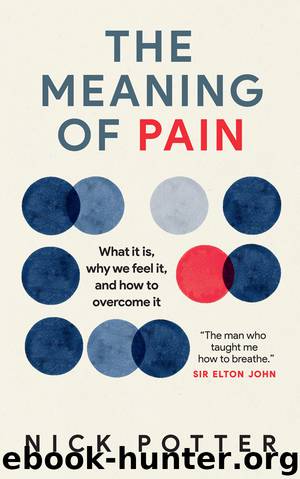The Meaning of Pain: What It Is, Why We Feel It, and How to Overcome It by Nick Potter

Author:Nick Potter [Potter, Nick]
Language: eng
Format: epub
ISBN: 9781780723914
Amazon: 1780723903
Goodreads: 45856265
Publisher: Short Books Ltd
Published: 2019-05-15T23:00:00+00:00
Figure 6. Stages of degeneration of a disc from top to bottom. Believe it or not, most of these will not cause pain if the back and core are kept strong.
Figure 7. Different degrees of disc bulging. Again, all may be pain-free.
If the compression is severe, it interferes with the transmission of impulses in the nerve and will affect sensory perception and be felt as pins and needles or numbness in the distribution of that nerve. In rare cases, the motor fibres to the muscles are affected, with resultant weakness in them. Footdrop, which results in the inability to lift the foot off the ground, is an example of this. It is extremely debilitating and disabling and it is often necessary to operate to remove the disc, as the nerve can be permanently damaged if not relieved quickly.
There is only one other acute necessity for surgery and that is when the disc has effectively herniated so much that it occupies a large section of the canal space which should house the base of the spinal cord. We call it the cauda equina (horse’s tail) because at this level there is no actual spinal cord, only a skein-like bundle of nerve roots. Again, this is very rare but does happen and can cause loss of urinary and bowel function, as well as loss of sensation to the nether regions and erectile dysfunction. Such symptoms require urgent assessment with an MRI scan and a neurosurgeon. Cauda equina syndrome usually happens because the nerves are compressed acutely and without warning. I say this because it is quite common to find, almost incidentally, that patients have compression of the same nerves by slow bony overgrowth into the canal (canal stenosis) equivalent to that of the acute disc. However, they have no symptoms at all. This is because in this case, with time, the nerve roots can adopt a new position and adapt to the squeeze. Here, the scan should be used to confirm the diagnosis only if symptoms develop and based on a good clinical examination.
The other anatomical structure in the spine most commonly involved in back pain is the facet joint (Figure 8 below). Each vertebra is linked by two sets of facet joints. One pair faces upward and one downward. They are located at the back of the spine, and have a flat face, lined with cartilage. They are synovial joints, which means that they can get inflamed and cause pain as they have a membrane around them (the capsule) which is pain-sensitive. This capsule is supplied by a hair-like nerve called the medial branch.
Download
This site does not store any files on its server. We only index and link to content provided by other sites. Please contact the content providers to delete copyright contents if any and email us, we'll remove relevant links or contents immediately.
| Anesthesiology | Colon & Rectal |
| General Surgery | Laparoscopic & Robotic |
| Neurosurgery | Ophthalmology |
| Oral & Maxillofacial | Orthopedics |
| Otolaryngology | Plastic |
| Thoracic & Vascular | Transplants |
| Trauma |
When Breath Becomes Air by Paul Kalanithi(7291)
Why We Sleep: Unlocking the Power of Sleep and Dreams by Matthew Walker(5678)
Paper Towns by Green John(4190)
The Immortal Life of Henrietta Lacks by Rebecca Skloot(3841)
The Sports Rules Book by Human Kinetics(3612)
Dynamic Alignment Through Imagery by Eric Franklin(3510)
ACSM's Complete Guide to Fitness & Health by ACSM(3481)
Kaplan MCAT Organic Chemistry Review: Created for MCAT 2015 (Kaplan Test Prep) by Kaplan(3436)
Introduction to Kinesiology by Shirl J. Hoffman(3315)
Livewired by David Eagleman(3153)
The River of Consciousness by Oliver Sacks(3008)
Alchemy and Alchemists by C. J. S. Thompson(2923)
The Death of the Heart by Elizabeth Bowen(2920)
Descartes' Error by Antonio Damasio(2757)
Bad Pharma by Ben Goldacre(2742)
The Gene: An Intimate History by Siddhartha Mukherjee(2510)
Kaplan MCAT Behavioral Sciences Review: Created for MCAT 2015 (Kaplan Test Prep) by Kaplan(2500)
The Fate of Rome: Climate, Disease, and the End of an Empire (The Princeton History of the Ancient World) by Kyle Harper(2452)
The Emperor of All Maladies: A Biography of Cancer by Siddhartha Mukherjee(2446)
